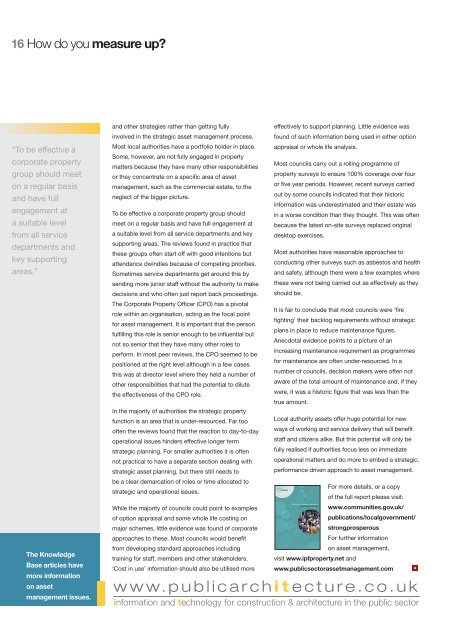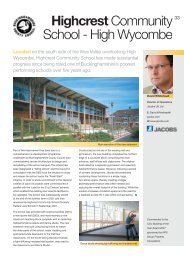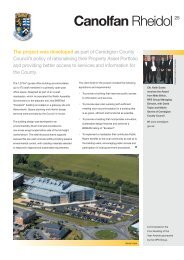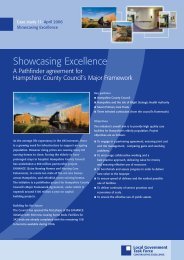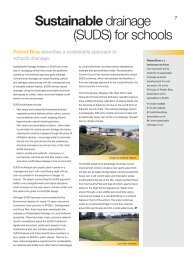How do you measure up? - Public Architecture
How do you measure up? - Public Architecture
How do you measure up? - Public Architecture
You also want an ePaper? Increase the reach of your titles
YUMPU automatically turns print PDFs into web optimized ePapers that Google loves.
16 <strong>How</strong> <strong>do</strong> <strong>you</strong> <strong>measure</strong> <strong>up</strong>?<br />
“To be effective a<br />
corporate property<br />
gro<strong>up</strong> should meet<br />
on a regular basis<br />
and have full<br />
engagement at<br />
a suitable level<br />
from all service<br />
departments and<br />
key s<strong>up</strong>porting<br />
areas.”<br />
The Knowledge<br />
Base articles have<br />
more information<br />
on asset<br />
management issues.<br />
and other strategies rather than getting fully<br />
involved in the strategic asset management process.<br />
Most local authorities have a portfolio holder in place.<br />
Some, however, are not fully engaged in property<br />
matters because they have many other responsibilities<br />
or they concentrate on a specific area of asset<br />
management, such as the commercial estate, to the<br />
neglect of the bigger picture.<br />
To be effective a corporate property gro<strong>up</strong> should<br />
meet on a regular basis and have full engagement at<br />
a suitable level from all service departments and key<br />
s<strong>up</strong>porting areas. The reviews found in practice that<br />
these gro<strong>up</strong>s often start off with good intentions but<br />
attendance dwindles because of competing priorities.<br />
Sometimes service departments get around this by<br />
sending more junior staff without the authority to make<br />
decisions and who often just report back proceedings.<br />
The Corporate Property Officer (CPO) has a pivotal<br />
role within an organisation, acting as the focal point<br />
for asset management. It is important that the person<br />
fulfilling this role is senior enough to be influential but<br />
not so senior that they have many other roles to<br />
perform. In most peer reviews, the CPO seemed to be<br />
positioned at the right level although in a few cases<br />
this was at director level where they held a number of<br />
other responsibilities that had the potential to dilute<br />
the effectiveness of the CPO role.<br />
In the majority of authorities the strategic property<br />
function is an area that is under-resourced. Far too<br />
often the reviews found that the reaction to day-to-day<br />
operational issues hinders effective longer term<br />
strategic planning. For smaller authorities it is often<br />
not practical to have a separate section dealing with<br />
strategic asset planning, but there still needs to<br />
be a clear demarcation of roles or time allocated to<br />
strategic and operational issues.<br />
While the majority of councils could point to examples<br />
of option appraisal and some whole life costing on<br />
major schemes, little evidence was found of corporate<br />
approaches to these. Most councils would benefit<br />
from developing standard approaches including<br />
training for staff, members and other stakeholders.<br />
‘Cost in use’ information should also be utilised more<br />
effectively to s<strong>up</strong>port planning. Little evidence was<br />
found of such information being used in either option<br />
appraisal or whole life analysis.<br />
Most councils carry out a rolling programme of<br />
property surveys to ensure 100% coverage over four<br />
or five year periods. <strong>How</strong>ever, recent surveys carried<br />
out by some councils indicated that their historic<br />
information was underestimated and their estate was<br />
in a worse condition than they thought. This was often<br />
because the latest on-site surveys replaced original<br />
desktop exercises.<br />
Most authorities have reasonable approaches to<br />
conducting other surveys such as asbestos and health<br />
and safety, although there were a few examples where<br />
these were not being carried out as effectively as they<br />
should be.<br />
It is fair to conclude that most councils were ‘fire<br />
fighting’ their backlog requirements without strategic<br />
plans in place to reduce maintenance figures.<br />
Anec<strong>do</strong>tal evidence points to a picture of an<br />
increasing maintenance requirement as programmes<br />
for maintenance are often under-resourced. In a<br />
number of councils, decision makers were often not<br />
aware of the total amount of maintenance and, if they<br />
were, it was a historic figure that was less than the<br />
true amount.<br />
Local authority assets offer huge potential for new<br />
ways of working and service delivery that will benefit<br />
staff and citizens alike. But this potential will only be<br />
fully realised if authorities focus less on immediate<br />
operational matters and <strong>do</strong> more to embed a strategic,<br />
performance driven approach to asset management.<br />
For more details, or a copy<br />
of the full report please visit:<br />
www.communities.gov.uk/<br />
publications/localgovernment/<br />
strongprosperous<br />
For further information<br />
on asset management,<br />
visit www.ipfproperty.net and<br />
www.publicsectorassetmanagement.com<br />
w w w. p u b l i c a r c h i t e c t u r e . c o . u k<br />
information and technology for construction & architecture in the public sector


